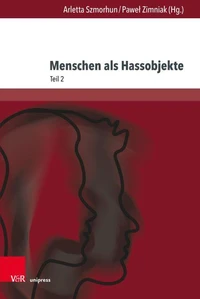Fremdes zwischen Teilhabe und Distanz. Fluktuationen von (Nicht - )Zugehörigkeiten in Sprache, Literatur und Kultur, Teil 1
Par : , , ,Formats :
Disponible dans votre compte client Decitre ou Furet du Nord dès validation de votre commande. Le format PDF est :
- Compatible avec une lecture sur My Vivlio (smartphone, tablette, ordinateur)
- Compatible avec une lecture sur liseuses Vivlio
- Pour les liseuses autres que Vivlio, vous devez utiliser le logiciel Adobe Digital Edition. Non compatible avec la lecture sur les liseuses Kindle, Remarkable et Sony
 , qui est-ce ?
, qui est-ce ?Notre partenaire de plateforme de lecture numérique où vous retrouverez l'ensemble de vos ebooks gratuitement
Pour en savoir plus sur nos ebooks, consultez notre aide en ligne ici
- Nombre de pages349
- FormatPDF
- ISBN978-3-8470-1260-3
- EAN9783847012603
- Date de parution12/07/2021
- Protection num.pas de protection
- Taille4 Mo
- Infos supplémentairespdf
- ÉditeurV&R Unipress
Résumé
Das Phänomen des Fremden kann - durch Schematismen sozialer Interaktion gesteuert - eine ebenso anziehende wie abstoßende Wirkung erzielen. Oft sind es minimale Situationsverschiebungen bzw. Kontextveränderungen, die die Frage nach sozialer Inklusion oder Exklusion regeln, ohne dabei zeitlich stabil zu sein. Zuschreibungen, Etikettierungen, Stereotypisierungen, Stigmatisierungen und Diskriminierungen, die sich auf religiöse, ethnische, geschlechtliche, weltanschauliche oder ökonomische Kategorien stützen, sorgen dafür, dass Ungleichheiten interaktiv über symbolische Grenzziehungen (re-)produziert und Räume des Eigenen und des Fremden abgesteckt werden.
Am Beispiel literatur-, kultur- und sprachwissenschaftlicher Analysen zeigen die Beiträge, dass die Problematisierung des Fremden nicht erst durch große Migrations- und Geflüchtetenströme an Bedeutung gewinnt, sondern auch in seiner sozialen Variante zur Geltung kommt und krisenhafte Begegnungen und/oder leidvolle Auseinandersetzungen mit sich bringt. The volume investigates in depth the phenomenon of the foreigner, who - controlled by the schemata of social interaction - can achieve both attractive and repulsive effects.
These are often minimal situational shifts or context changes that determine the option for one side or the other and regulate the issue of social inclusion/exclusion without being stable over time. Attributions, labelling, stereotyping, stigmatization and discrimination that (can be) based on religious, ethnic, gender, ideological, economic, medical etc. categories ensure that inequalities are (re-)produced in an interactive way via symbolic demarcations and the fields of one's own and the stranger's are being sealed.
It is shown in this context, using examples of literary, cultural and linguistic analyses, that the problem of the foreigner does not only take on importance in light of the big wave of migration and refugees, but also comes into its own in its social variant and entails (no less) critical encounters and/or painful arguments.
Am Beispiel literatur-, kultur- und sprachwissenschaftlicher Analysen zeigen die Beiträge, dass die Problematisierung des Fremden nicht erst durch große Migrations- und Geflüchtetenströme an Bedeutung gewinnt, sondern auch in seiner sozialen Variante zur Geltung kommt und krisenhafte Begegnungen und/oder leidvolle Auseinandersetzungen mit sich bringt. The volume investigates in depth the phenomenon of the foreigner, who - controlled by the schemata of social interaction - can achieve both attractive and repulsive effects.
These are often minimal situational shifts or context changes that determine the option for one side or the other and regulate the issue of social inclusion/exclusion without being stable over time. Attributions, labelling, stereotyping, stigmatization and discrimination that (can be) based on religious, ethnic, gender, ideological, economic, medical etc. categories ensure that inequalities are (re-)produced in an interactive way via symbolic demarcations and the fields of one's own and the stranger's are being sealed.
It is shown in this context, using examples of literary, cultural and linguistic analyses, that the problem of the foreigner does not only take on importance in light of the big wave of migration and refugees, but also comes into its own in its social variant and entails (no less) critical encounters and/or painful arguments.
Das Phänomen des Fremden kann - durch Schematismen sozialer Interaktion gesteuert - eine ebenso anziehende wie abstoßende Wirkung erzielen. Oft sind es minimale Situationsverschiebungen bzw. Kontextveränderungen, die die Frage nach sozialer Inklusion oder Exklusion regeln, ohne dabei zeitlich stabil zu sein. Zuschreibungen, Etikettierungen, Stereotypisierungen, Stigmatisierungen und Diskriminierungen, die sich auf religiöse, ethnische, geschlechtliche, weltanschauliche oder ökonomische Kategorien stützen, sorgen dafür, dass Ungleichheiten interaktiv über symbolische Grenzziehungen (re-)produziert und Räume des Eigenen und des Fremden abgesteckt werden.
Am Beispiel literatur-, kultur- und sprachwissenschaftlicher Analysen zeigen die Beiträge, dass die Problematisierung des Fremden nicht erst durch große Migrations- und Geflüchtetenströme an Bedeutung gewinnt, sondern auch in seiner sozialen Variante zur Geltung kommt und krisenhafte Begegnungen und/oder leidvolle Auseinandersetzungen mit sich bringt. The volume investigates in depth the phenomenon of the foreigner, who - controlled by the schemata of social interaction - can achieve both attractive and repulsive effects.
These are often minimal situational shifts or context changes that determine the option for one side or the other and regulate the issue of social inclusion/exclusion without being stable over time. Attributions, labelling, stereotyping, stigmatization and discrimination that (can be) based on religious, ethnic, gender, ideological, economic, medical etc. categories ensure that inequalities are (re-)produced in an interactive way via symbolic demarcations and the fields of one's own and the stranger's are being sealed.
It is shown in this context, using examples of literary, cultural and linguistic analyses, that the problem of the foreigner does not only take on importance in light of the big wave of migration and refugees, but also comes into its own in its social variant and entails (no less) critical encounters and/or painful arguments.
Am Beispiel literatur-, kultur- und sprachwissenschaftlicher Analysen zeigen die Beiträge, dass die Problematisierung des Fremden nicht erst durch große Migrations- und Geflüchtetenströme an Bedeutung gewinnt, sondern auch in seiner sozialen Variante zur Geltung kommt und krisenhafte Begegnungen und/oder leidvolle Auseinandersetzungen mit sich bringt. The volume investigates in depth the phenomenon of the foreigner, who - controlled by the schemata of social interaction - can achieve both attractive and repulsive effects.
These are often minimal situational shifts or context changes that determine the option for one side or the other and regulate the issue of social inclusion/exclusion without being stable over time. Attributions, labelling, stereotyping, stigmatization and discrimination that (can be) based on religious, ethnic, gender, ideological, economic, medical etc. categories ensure that inequalities are (re-)produced in an interactive way via symbolic demarcations and the fields of one's own and the stranger's are being sealed.
It is shown in this context, using examples of literary, cultural and linguistic analyses, that the problem of the foreigner does not only take on importance in light of the big wave of migration and refugees, but also comes into its own in its social variant and entails (no less) critical encounters and/or painful arguments.







